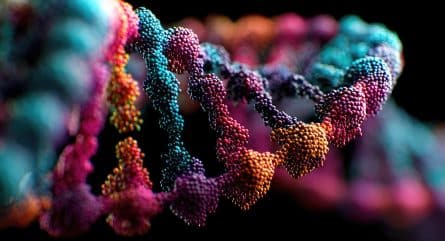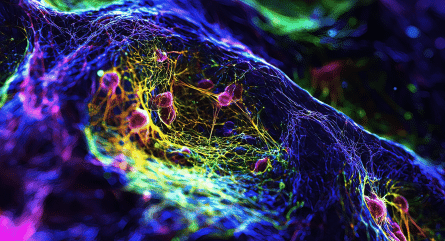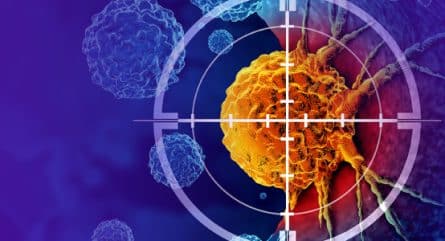In today’s world of weight loss, you can choose from paleo diets, intermittent fasting, high-output cardio workouts, laser therapy, and gastric bands. In tomorrow’s world, you might also be able to select CRISPR.
For the past several years, scientists have been working on a process to modify the genes of people who are trying to lose weight. That process involves a tweaked CRISPR method called CRISPRa, with the “a” standing for “activation.” CRISPRa activates genes at the transcriptional level instead of cutting the genome.
CRISPR weight loss without gene editing
One of the foundational studies exploring CRISPR and weight loss was a Science article from December 2018 in which a group of researchers led by Nadav Ahituv of the University of California at San Francisco injected CRISPRa-rAAV into the hypothalamus of mice—that act led to the reversal of the obesity phenotypes in Sim1 and Mc4r haploinsufficient mice. They used a viral delivery system to introduce the CRISPRa constructs into the hunger-control regions of the brain in mice that were genetically engineered to have only one functional copy of either gene.
The work described “how a modified version of CRISPR was used to ramp up the activity of certain genes and prevent severe obesity in mice with genetic mutations that predispose them to extreme weight gain. Importantly, the researchers achieved long-lasting weight control without making a single edit to the genome,” noted a press release from the college.
CRISPR used to shed fat, improve glucose metabolism in mice
In a more recent obesity study, published in Science Translational Medicine, an international collection of researchers used CRISPR gene editing to give human white fat cells the same properties as brown fat. These CRISPR-modified cells were termed HUMBLE (human brown-like) cells. The researchers then transplanted the fat into mice, which were subsequently fed a high-fat diet. Over a 12-week period, mice transplanted with white fat gained weight, but those transplanted with brown fat or HUMBLE cells gained much less weight and showed signs of being protected against diabetes.
White fat stores energy in big oily droplets throughout the body, while brown fat contains smaller droplets and high amounts of mitochondria. Brown fat is what babies have, and adults lose it as they age. HUMBLE cells were created by the researchers, who engineered human white preadipocytes using CRISPR-Cas9-SAM-gRNA.
Study author Yua-Hua Tseng described the CRISPR experiment to WBUR in Boston: “Brown fat has a very unique feature, a unique protein expressed in it, called Uncoupling Protein 1, or UCP1. It’s a protein basically located in mitochondria, the power source of the cells, that can turn chemical energy into heat for dissipation. We know normal white fat doesn’t express the UCP1 protein. So we used CRISPR to turn on UCP1 expression in white fat, to wake up those genes so the white fat can start to express this important protein to dissipate energy. We didn’t directly turn the white fat in mice into brown fat. We actually engineered human white fat cells into HUMBLE cells, brown-like cells, and then we transplanted the cells into mice, and we found the mice receiving the transplanted HUMBLE cells had a much-improved metabolism. Even when we gave them a high-calorie, high-fat diet, they gained less weight.”
While the overall weight loss was not huge, the 5-10% improvement in glucose metabolism was better, Tseng said.
How might the finding be used? In theory, you could take a tiny bit of fat tissue from an overweight person, purify precursor cells from it, edit their genomes to make them into brown-like HUMBLE cells, then put them back in the overweight person. While a pill is in development which would stimulate brown fat, some people might respond better to the cell therapy, and with improvements, CRISPR could become a common hospital routine.
Gene therapy reduced body weight by 20%
Looking for hard numbers when it comes to weight loss? How does 20% sound?
A 2019 study in Genome Research by South Korean researchers used CRISPRi—the “i” stands for “interference”—and a targeted nonviral gene delivery system to treat obesity and obesity-induced type 2 diabetes. Targeted delivery of CRISPRi effectively silenced fatty acid-binding protein 4 (Fabp4), resulting in lower body weight and inflammation in obese mice.
“Fabp4 repression resulted in a 20% reduction of body weight and improved insulin resistance and inflammation after just six weeks of treatment,” noted Science Daily. “Additional systemic improvements were observed, including a reduction in fatty lipid deposition in the liver and reduced circulating triglycerides.”
And all of this was accomplished—as the future advertisement might declare—without reducing what they ate or exercising more.
Although the results are preliminary, “we hypothesize that the use of a nonviral prohibitin-targeting gene delivery system to direct the CRISPRi system consisting of dead Cas9 and Fabp4 sgRNA to adipose tissues can be an efficient and potential strategy for treating obesity and obesity-induced metabolic syndromes,” the authors wrote.
While a big deal for the overweight mice, human trials are likely a ways off, meaning that—for the time being—the ticket to weight loss is still good-old exercise and healthy eating.


























